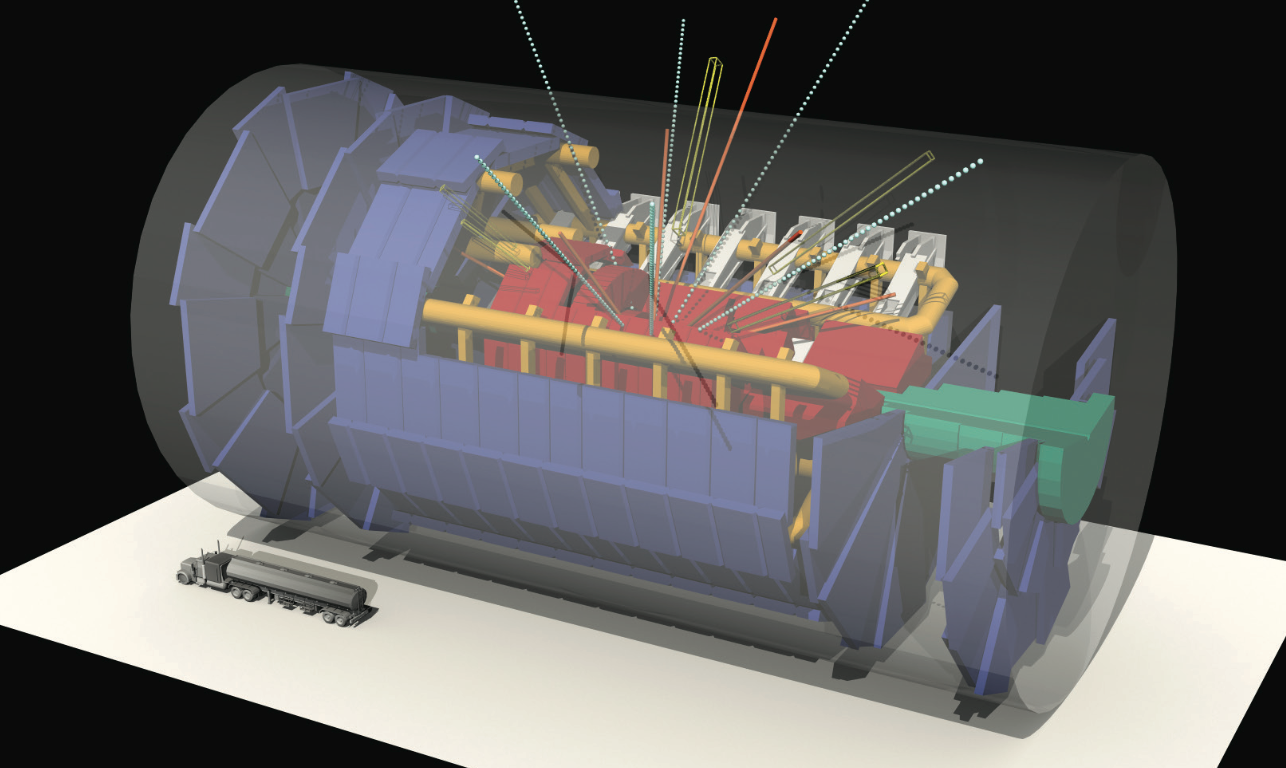Advancing science at the smallest scales calls for vast data from the world’s most powerful particle accelerator, leavened with the precise theoretical predictions made possible through many hours of supercomputer processing.
The combination has worked before, when scientists from the Department of Energy’s Argonne National Laboratory provided timely predictions about the Higgs particle at the Large Hadron Collider in Switzerland. Their predictions contributed to the 2012 discovery of the Higgs, the subatomic particle that gives mass to all elementary particles.
“That we are able to predict so precisely what happens around us in nature is a remarkable achievement,” Argonne physicist Radja Boughezal says. “To put all these pieces together to get a number that agrees with the measurement that was made with something so complicated as the LHC is always exciting.”
Earlier this year, she was allocated more than 98 million processor hours on the Mira and Theta supercomputers at the Argonne Leadership Computing Facility, a DOE Office of Science user facility, through DOE’s INCITE (Innovative and Novel Computational Impact on Theory and Experiment) program. Her previous INCITE allocation helped solve problems that scientists saw as insurmountable just two or three years ago.
These problems stem from the increasingly intricate and precise measurements and theoretical calculations associated with scrutinizing the Higgs boson and from searches for subtle deviations from the standard model that underpins the behavior of matter and energy. The approach she and her associates developed led to early, high-precision LHC predictions that describe so-called strong-force interactions between quarks and gluons, which comprise subatomic particles such as protons and neutrons.
The theory governing strong-force interactions is called QCD, for quantum chromodynamics. In QCD, the thing that quantifies the strong force when exerted in any direction is called the strong coupling constant.
“At high energies, when collisions happen, quarks and gluons are very close to each other, so the strong force is very weak. It’s almost turned off,” Boughezal explains. How this strong coupling grows – a small parameter called perturbative expansion – gives physicists a yardstick to calculate their predictions. Perturbative expansion is “a method we have used over and over to get these predictions, and it has provided powerful tests of QCD to date.”
Crucial to these tests is the N-jettiness framework Boughezal and her Argonne and Northwestern University collaborators devised to obtain high-precision predictions for particle scattering processes. Specially adapted for high-performance computing systems, the framework’s novelty stems from its incorporation of existing low-precision numerical codes to achieve part of the desired result. The scientists fill in algorithmic gaps with simple analytic calculations.
The LHC data lined up completely with predictions the team had obtained from running the N-jettiness code on the Mira supercomputer at Argonne. The agreement carries important implications for the precision goals physicists are setting for future accelerators such as the proposed Electron-Ion Collider (EIC).
“One of the things that has puzzled us for 30 years is the spin of the proton,” Boughezal says. Planners hope the EIC reveals how the spin of the proton, matter’s basic building block, emerges from its elementary constituents, quarks and gluons.
Boughezal also is working with LHC scientists in the search for dark matter, which accounts for 96 percent of stuff in the universe. The remainder is ordinary matter, the atoms and molecules that form stars, planets and people.
Neutrinos appear as missing energy in the LHC’s detectors, just as a dark matter particle would.
“Scientists believe that the mysterious dark matter in the universe could leave a missing energy footprint at the LHC,” she says. Such a footprint would reveal the existence of a new particle that’s currently missing from the standard model. Dark matter particles interact weakly with the LHC’s detectors. “We cannot see them directly.”
They could, however, be produced with a jet – a spray of standard-model particles made from LHC proton collisions. “We can measure that jet. We can see it. We can tag it.” And by using simple laws of physics such as the conservation of momentum, even if the particles are invisible, scientists would be able to detect them by measuring the jet’s energy.
For example, when subatomic particles called Z bosons are produced with particle jets, the bosons can decay into neutrinos, ghostly specks that rarely interact with ordinary matter. The neutrinos appear as missing energy in the LHC’s detectors, just as a dark matter particle would.
In July 2017, Boughezal and three co-authors published a paper in the Journal of High Energy Particle Physics. It was the first to describe new proton-structure details derived from precision high-energy Z-boson experimental data.
“If you want to know whether what you have produced is actually coming from a standard model process or something else that we have not seen before, you need to predict your standard model process very well,” she says. If the theoretical predictions deviate from the experimental data, it suggests new physics at play.
In fact, Boughezal and her associates have precisely predicted the standard model jet process and it agrees with the data. “So far we haven’t produced dark matter at the LHC.”
Previously, however, the results were so imprecise – and the margin of uncertainty so high – that physicists couldn’t tell whether they’d produced a standard-model jet or something entirely new.
What surprises will higher-precision calculations reveal in future LHC experiments?
“There is still a lot of territory that we can probe and look for something new,” Boughezal says. “The standard model is not a complete theory because there is a lot it doesn’t explain, like dark matter. We know that there has to be something bigger than the standard model.”
Argonne is managed by UChicago Argonne LLC for the DOE Office of Science. The Office of Science is the single largest supporter of basic research in the physical sciences in the United States and is working to address some of the most pressing challenges of our time. For more information, please visit science.energy.gov.
